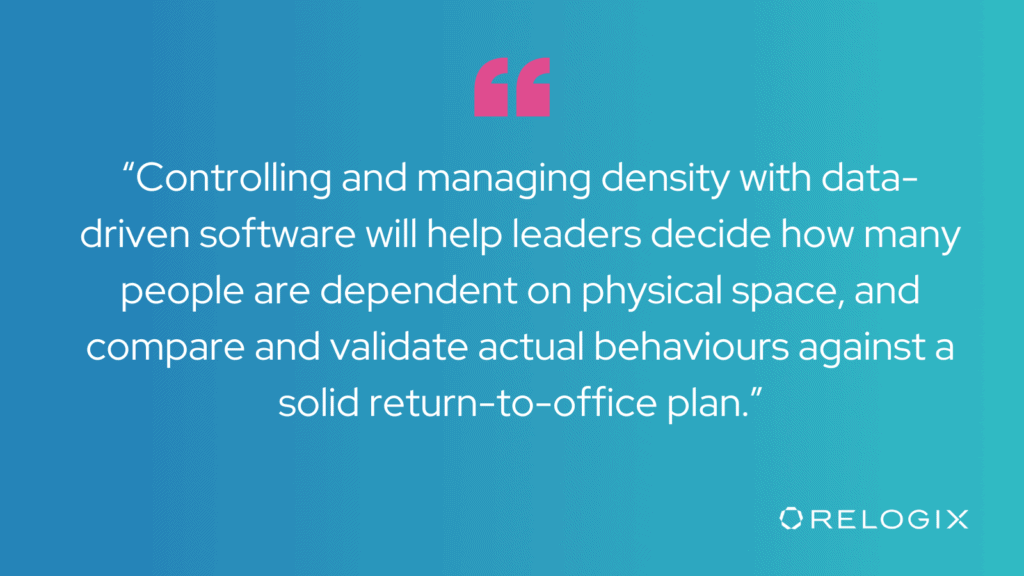Workplace Density: The One Thing You Can’t Miss in your Back-to-Office Plans
Returning to the office after the pandemic will throw a ton of new challenges at most companies, especially when it comes to managing the use of their office space. Obviously, things will have to change to ensure everyone’s safety and health but managing density in the workplace is a necessity.
Before the pandemic, when growth or an acquisition meant lots of new hires, companies usually increased workplace density. This meant giving each employee less desk space and squeezing in as many people as possible. The main concern here was to save money, and this strategy was only limited by building or fire codes.
If your company chose this route, you might now be having trouble with return-to-office plans. Unsurprisingly, high-density office spaces aren’t looking very attractive to returning employees. After a year of keeping our distance, physical and psychological health are at the top of everyone’s minds.
For many organizations, the idea of retrofitting the workplace can feel overwhelming—the pandemic isn’t over, and we know new strains of the virus are bound to emerge. In some countries, companies have a “duty of care” towards their employees to protect their health, so doing nothing isn’t an option.
The good news: sensor technology can help you reduce density to avoid the immediate need for a complete retrofit. Which approach to take just depends on your organization’s goals and resources.

Workplace density can be a tricky concept. There’s a mathematical measurement: how many desks are in how much space? But more importantly, density is measured through employees’ perceptions. How small is the desk? How close are the desks to each other? An office can feel pretty bleak when the desks are too far apart. It’s hard to say whether the ‘office buzz’ that once was will be perceived as good or bad by office occupants moving forward and if a lower key office with less buzz and more purposeful use will be the permanent way forward.
The biggest hurdle for returning to the office is making sure employees feel like they’re able to stay safe and healthy at work. If the pandemic had been shorter, bringing people back to the office might have been a whole lot easier. Even with HR teams deciding which jobs could be done from home, it will be tough to convince employees that are expected to return that their jobs must be done in the office. As the pandemic stretched on, people adapted to getting their work done from home. They also got used to their new habits and routines, like avoiding public transit, no long commutes, and conducting much of their interactions with colleagues, customers, vendors, and partners, online. Safety in the office is about minimizing density, and making sure each person perceives available spaces as safe.
Controlling and managing density with data-driven software will help leaders decide how many people are dependent on physical space, and compare and validate actual behaviours against a solid return-to-office plan.

To control density, there are a few easy steps you can take:
- Accommodate preferences. Continue to support and encourage employees to work outside the office, if they can and want to, all while ramping up return-to-office plans.
- Limit occupancy. Limit the number of desk seats available per floor and/or how many people are allowed to be inside the building, on a floor, or in a space at one time. Use technology to do this effectively—take a look at desk booking solutions and health check surveys. Both can give you insight into employees’ intentions and preferences.
- Restrict use of space. Remove desks and seats, or otherwise make some spaces unavailable. If you’re using a desk booking tool, spaces can be limited to a set maximum per day. They can also help space employees out, to help with physical distancing.
- Repurpose/re-design spaces. Turn cramped cubicles into open, soft seating that makes it easier for people to maintain safe physical distancing.
Setting occupancy limits is easy. Actively managing and maintaining those limits to control office density is not—at least, without the use of sensors. Sensor technology is essential if you want to make sure employees build resilience and feel safe at work. Don’t overlook it!
Managing Your Density
If managing your office density is important to you, you need access to timely data.
To begin to understand how an office space was meant to be used, just look at its design. If you see mostly individual work areas, you can assume it was meant for mostly heads-down work. If there are more meeting and ancillary spaces, the office was meant for more face-to-face interactions to support a collaborative, meeting-centric culture.
Sensor data can help you identify when the actual use of a space is different from its original purpose. As we know, space use guidelines are just suggestions; people end up using space as they see fit. Sensor data allows you to compare design intent with employee intent and hone in on misalignments which can inform the necessary workspace design changes.

We’re at a point where the use of office space is continually evolving, which means historical pre-pandemic data isn’t helpful anymore for future planning. For longer-term initiatives, you’ll need “as-it-happens” data—data that shows you how employees are currently interacting with the space to identify what has changed.
For example, before the pandemic, people might have come to the office to work at their desk, the data would have shown a higher demand for desks. Today, people might be coming to the office but the data might show the demand for desk space is significantly lower. Instead there is an increasing demand for meeting spaces, open collaboration spaces, lounges, cafes, and even private spaces like offices. Current data shows you the difference between the original intended use versus actual use and points out clear, actionable insights, even when occupancy levels are below 30%.
When people do come back to the office, the way they use space is likely to be much different than it was pre-pandemic. “Dwell time”, particularly, is a piece of data that’s becoming more and more important.
Dwell time captures the time someone continuously occupies a space. Knowing dwell time is important because it translates into a proper sharing ratio for each and every seat. Unlike utilization that looks at the average use of space over the number of hours the seat was available, dwell time is much more accurate in determining the total required seats to support demand.
What makes dwell time more meaningful is the idle time between dwells or the “in-between” time: the time that people are away from their desk. Idle time surfaces key insights about availability. For example, a desk that has 15 minutes of idle time between dwells will most likely not be time that can be used by someone else. However, if the idle time is 1 or more hours, it indicates that the desk could be used by someone else who might be looking for a place to sit for a shorter period of time when they are in the office.
In a flexible and hybrid work environment, people are likely to be much more mobile in the office than ever before. Gone are the days of an employee coming in and spending most of their day at their desk. Instead, the office will see more employees who need to meet with colleagues, vendors, partners, clients, etc., which they can’t do at home. The desk might turn into an “in-between” meeting space, which is not at all how most office spaces were originally intended to be used.
Don’t forget that most office spaces are made up of about 30% structured in-person meeting spaces. Coming back, it won’t be as simple as upping the availability of this space based on workplace analytics data. Instead, take the time to observe and learn how people actually interact with the space. Armed with this knowledge, you can be much more strategic about repurposing existing areas to better suit employee needs to ensure an optimal employee experience.

After such a long hiatus, employees will need time to get reacquainted with the workplace. They’ll need to regain a sense of confidence in going back to the office, so it’s essential that return-to-office policies put the health and well-being of every employee above all else. To win that confidence, companies will have to prove that they’re well aware of the changes that employees need, and show that they’re prepared to put them in place. This goes way beyond acrylic screens, hazard tape, and signage.
Still uncertain about where to begin with your return-to-office plans, or how to interpret the data you have to support your planning? Let our data and insight experts at Relogix show you the way.

